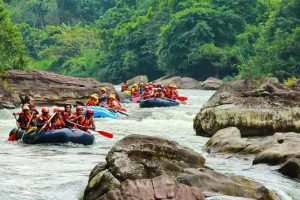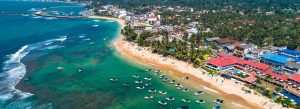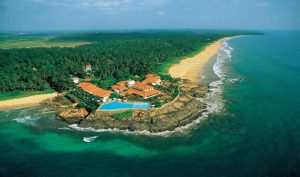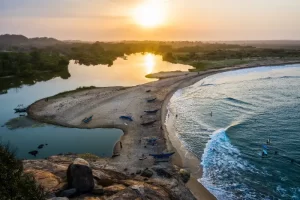If elephant watching is what you are looking for, Uda Walawe National Park is the Sri Lankan national park that in not second to the savannah reserves of Africa. With herds of elephants, wild buffalo, sambar deer and leopards, Uda Walawe National Park lies on the boundary of Sabaragamuwa and Uva Provinces, in Sri Lanka.
The national park was formed in 1972 on 30 th July, to provide a sanctuary for wild animals displaced by the construction of the Udawalawe Reservoir on the Walawe River, as well as to protect the catchment of the reservoir. The 30,821 hectares dry zone National Park is mainly a thorny-shrub jungle with grasslands. It has an annual rainfall of 1524 mm and an average temperature of about 29.4°C.
As mentioned earlier, Uda Walawe National Park is mostly famous for the many elephants that live there. During a visit, it is not unusual to see whole herds of adults and young elephants- feeding or bathing and playing in the water! In addition to this main attraction, the park is home to many water buffalo, water monitor lizards, sambar deer, monkeys and the occasional leopard whose sighting would be a bonus, as well as being an exciting location for bird watching enthusiasts.
Udawalawe National Park is unquestionably the best place in Sri Lanka to see wild Asian Elephants throughout the year: there are about 500 elephants in the park and they often roam in herds of up to 100. Udawalawe National Park is unique in terms of consistency in numbers of elephants roaming the park. The best time of the day to visit the park is in the mornings and evenings. In terms of photography, late evenings makes the loveliest backdrops with breathtaking sunsets.
Apart from elephants, Udawalawe National Park is one of the best places to see Raptors in Sri Lanka and afford excellent opportunities for photography. Widespread birds include the Ceylon Junglefowl, Ceylon Spurfowl, Ceylon Green Pigeon, Ceylon Grey Hornbill, Ceylon Woodshrike and Ceylon Swallow. Among the other bird species seen are Spot-billed Pelican, Little Cormorant, Grey Heron, Indian Pond Heron, Cattle Egret, Large Egret, Little Egret, Intermediate Egret, Painted Stork, Woolly-necked Stork, Yellow-wattled Lapwing, Green Bee-eater, Crested Tree-swift. In forested areas Sirkeer and Blue-faced Malkohas are found.
The Udawalawe National Park is also abundant with vegetation. Originally forested, grassland and thorn-scrub now predominate. Much of the forest was destroyed by chena, agricultural activities by farmers in the area. Tree species of the park include Satin, Halmilla, Ebony, Ehala, Kolon ( Adina cordifolia ), Milla ( Vitex pinnata ), Kon (Schleichera oleosa) and Kunumella ( Diospyros ovalifolia ). Scattered trees, constituting 20-50% of existing cover, are mainly satin, ehala and lunumidella ( Melia dubia ). In the riverine forest, kumbuk ( Terminalia arjuna ) and the endemic mandorang ( Hopea cordifolia ) are dominant. Scrub is dominated by damaniya (Grewia tiliaefolia ). Savanna grasslands are dominated by Mana ( Cymbogon confertiflorus) , Illuk (I mperata cylindrical ) and Pogon ( Pennisetum olystachyon)
In order to access entrance to the National park, there consists a few routes. The main entrance to Udawalawe National Park is located at the 7th milepost on Udawalawe-Thanamalvila road. The park can be reached from Colombo, the main seaport and the capital of Sri Lanka via the valley of Ratnapura, the main gem mining district of Sri Lanka. From Ratnapura, travelling via along Pelmadulla – Embilipitiya road to reach Colombage Ara junction, from where the entrance to Udawalawe National Park can be accessed. The total driving time from Colombo to Udawalawe National Park via Ratnapura is approximately four hours.
Since the main attraction of the Udawalawe National Park is the Asian Elephant, The Department of Wildlife in Sri Lanka in 1995, as an attempt to support the orphaned calves from the other areas of the island, set up the Elephant Transit Centre at Uda Walawe National Park itself with the support of Born Free Foundation. Twenty of the 32 calves are “foster arented”. As in the famous Pinnawela Elephant Orphanage, herein too you would have the joy of seeing the baby elephants being bottle fed. At the age of five, the young elephants are returned to the wild once more to live free. While some are born free in the wild, some are born in the captivity at Uda Walawe Elephant Transit Centre.











